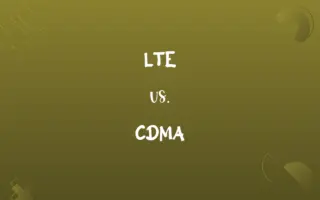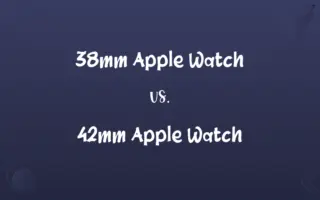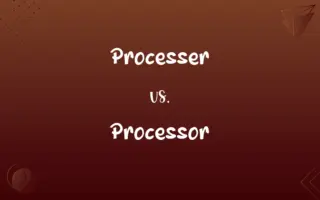Gap Junction vs. Tight Junction: Know the Difference

By Shumaila Saeed || Published on February 26, 2024
Gap junctions are cellular channels allowing material exchange between adjacent cells, whereas tight junctions create a watertight seal between cells to prevent material passage.

Key Differences
Gap Junctions are specialized structures in cellular membranes that form channels allowing direct communication between adjacent cells. They permit the transfer of ions, nutrients, and other small molecules, facilitating coordination of cell activities. Tight Junctions, in contrast, act as barriers that seal cells together, preventing the passage of molecules and ions through the space between cells. They create a watertight seal that regulates material movement in tissue environments.
Shumaila Saeed
Feb 26, 2024
Structurally, gap junctions are formed by connexons, which are proteins that create a tunnel-like connection between cells. This structure enables the rapid and direct transfer of signaling molecules and electrolytes. Tight junctions are composed of claudins and occludins, proteins that closely adhere to adjacent cell membranes, effectively blocking intercellular passage and maintaining cellular polarity.
Shumaila Saeed
Feb 26, 2024
Gap junctions are crucial in tissues that require rapid and coordinated cellular responses, like heart muscle and neurons. They facilitate synchronized contraction in cardiac tissue and are essential in the propagation of action potentials in the nervous system. Tight junctions are predominantly found in epithelial tissues, such as those lining the stomach, intestines, and blood-brain barrier, where they prevent the leakage of solutes and maintain distinct environments on either side of the tissue.
Shumaila Saeed
Feb 26, 2024
In terms of permeability, gap junctions allow selective permeability based on molecule size and charge, enabling cells to share small molecules and ions. Tight junctions, however, provide a robust barrier to the diffusion of solutes and water, ensuring controlled environment regulation within various body compartments.
Shumaila Saeed
Feb 26, 2024
Finally, the dysfunction of gap junctions can lead to uncoordinated cell behavior and is implicated in various diseases, including cardiac arrhythmias. Malfunctioning tight junctions can result in increased permeability, leading to conditions like inflammatory bowel disease or the breakdown of the blood-brain barrier.
Shumaila Saeed
Feb 26, 2024
ADVERTISEMENT
Comparison Chart
Structural Composition
Made of connexons forming channels
Composed of claudins and occludins forming seals
Shumaila Saeed
Feb 26, 2024
Primary Function
Allow material exchange between cells
Prevent material passage between cells
Shumaila Saeed
Feb 26, 2024
Location in the Body
Common in heart and nervous system
Found in epithelial tissues like intestines, skin
Shumaila Saeed
Feb 26, 2024
Permeability
Selectively permeable to small molecules and ions
Impermeable, blocking solute and water movement
Shumaila Saeed
Feb 26, 2024
Role in Tissue Function
Facilitate coordinated activities like contractions
Maintain distinct environments and prevent leakage
Shumaila Saeed
Feb 26, 2024
ADVERTISEMENT
Implications of Dysfunction
Can lead to disorders like cardiac arrhythmias
Can result in conditions like inflammatory bowel disease
Shumaila Saeed
Feb 26, 2024
Gap Junction and Tight Junction Definitions
Gap Junction
Gap junctions are essential in maintaining tissue homeostasis by allowing cellular cooperation.
Liver cells use gap junctions to regulate metabolism.
Shumaila Saeed
Jan 11, 2024
Tight Junction
Tight junctions help maintain distinct cellular environments by regulating material flow.
In the brain, tight junctions maintain the blood-brain barrier.
Shumaila Saeed
Jan 11, 2024
Gap Junction
Gap junctions facilitate the passage of small signaling molecules across cells in a tissue.
In the retina, gap junctions help in visual signal processing.
Shumaila Saeed
Jan 11, 2024
Tight Junction
Tight junctions contribute to cell polarity by segregating proteins to specific cell surfaces.
Tight junctions in intestinal cells separate digestive enzymes.
Shumaila Saeed
Jan 11, 2024
ADVERTISEMENT
Gap Junction
Gap junctions are intercellular channels formed by connexons for direct cell-to-cell communication.
Neurons use gap junctions for rapid signal transmission.
Shumaila Saeed
Jan 11, 2024
Tight Junction
Tight junctions are impermeable seals between cells that prevent the passage of substances.
Tight junctions in the gut lining prevent bacterial infiltration.
Shumaila Saeed
Jan 11, 2024
Gap Junction
Gap junctions support coordinated cell activity in various physiological processes.
Muscle tissue relies on gap junctions for uniform contraction.
Shumaila Saeed
Jan 11, 2024
Tight Junction
Tight junctions are composed of proteins that bind cells tightly together, maintaining tissue integrity.
Skin cells use tight junctions to form a protective barrier.
Shumaila Saeed
Jan 11, 2024
Gap Junction
Gap junctions are cellular connections that allow for the exchange of ions and molecules between adjacent cells.
Gap junctions in heart cells enable synchronized heartbeats.
Shumaila Saeed
Jan 11, 2024
Tight Junction
Tight junctions are crucial in preventing the leakage of fluids and solutes across epithelial layers.
Bladder epithelium relies on tight junctions to contain urine.
Shumaila Saeed
Jan 11, 2024
Repeatedly Asked Queries
What are gap junctions?
Gap junctions are cellular structures allowing direct communication between adjacent cells.
Shumaila Saeed
Feb 26, 2024
How do gap junctions function?
They enable the transfer of ions and small molecules between cells.
Shumaila Saeed
Feb 26, 2024
What are tight junctions?
Tight junctions are barriers that seal cells together to prevent material passage.
Shumaila Saeed
Feb 26, 2024
What is the role of tight junctions in the body?
They maintain distinct environments in tissues by blocking solute movement.
Shumaila Saeed
Feb 26, 2024
Where are gap junctions commonly found?
In cardiac and nervous tissues, facilitating synchronized activities.
Shumaila Saeed
Feb 26, 2024
Can gap junctions transfer large molecules?
No, they mainly allow the passage of small ions and molecules.
Shumaila Saeed
Feb 26, 2024
Do tight junctions regulate fluid flow in tissues?
Yes, they prevent the uncontrolled flow of fluids across cell layers.
Shumaila Saeed
Feb 26, 2024
Are gap junctions involved in cellular signaling?
Yes, they facilitate rapid signaling between cells.
Shumaila Saeed
Feb 26, 2024
Can the malfunction of gap junctions cause diseases?
Yes, it can lead to conditions like cardiac arrhythmias.
Shumaila Saeed
Feb 26, 2024
Do tight junctions contribute to tissue integrity?
Yes, they play a key role in maintaining tissue structure and function.
Shumaila Saeed
Feb 26, 2024
Are gap junctions and tight junctions visible under a microscope?
Yes, with specialized staining and electron microscopy.
Shumaila Saeed
Feb 26, 2024
What proteins are involved in forming tight junctions?
Claudins and occludins are key proteins in tight junction formation.
Shumaila Saeed
Feb 26, 2024
Can gap junctions be found in all types of cells?
No, they are specific to certain tissues like the heart and nervous system.
Shumaila Saeed
Feb 26, 2024
How do tight junctions protect against pathogens?
By creating barriers that prevent pathogen infiltration into tissues.
Shumaila Saeed
Feb 26, 2024
Do tight junctions have a role in nutrient absorption?
Yes, they regulate the passage of nutrients in organs like the intestines.
Shumaila Saeed
Feb 26, 2024
Do tight junctions affect cell polarity?
Yes, they help establish and maintain cell polarity.
Shumaila Saeed
Feb 26, 2024
How do gap junctions aid in tissue homeostasis?
By allowing cells to share resources and signals, maintaining balance.
Shumaila Saeed
Feb 26, 2024
Are gap junctions important for embryonic development?
Yes, they are crucial for cell communication during development.
Shumaila Saeed
Feb 26, 2024
What happens if tight junctions are disrupted?
It can result in increased permeability and associated disorders.
Shumaila Saeed
Feb 26, 2024
Can gap junctions facilitate the spread of cell damage?
Yes, damaging signals can propagate through gap junctions.
Shumaila Saeed
Feb 26, 2024
Share this page
Link for your blog / website
HTML
Link to share via messenger
About Author
Written by
Shumaila SaeedShumaila Saeed, an expert content creator with 6 years of experience, specializes in distilling complex topics into easily digestible comparisons, shining a light on the nuances that both inform and educate readers with clarity and accuracy.



































































